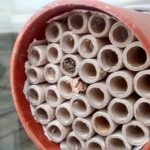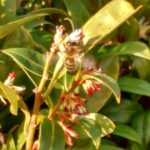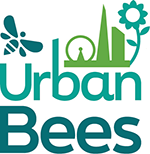I’ve not known a whole month like January when woke up to a carpet of hard frost in the back garden every day and had to put on five layers, including leggings under my jeans and two pairs of socks to cycle the 20 mins to work in central London! The temperature has hovered around 5 C. So did the bees cope? Well actually this is better for them, than a mild winter when they’re out flying and using up their energy reserves. Honeybees huddle in their hive, keeping it nice and toasty by using their bodies and wings to create a shivering sensation that heats them and their home. (Rather like penguins on the ice). The cluster of some 10,000 worker bees and their queen will eat the honey left by the beekeeper. That’s fine if they’ve enough stores and it’s easy to get to it. Problems can occur if it’s a mild winter when they need to eat more honey to fuel their flights outside the hive looking for the very few plants that are flowering.
FEEDING HONEYBEES FONDANT
Given the mild December, many beekeepers (even the ones like us that left each hive a super of honey) were out by mid January putting some bakers’ fondant on the top of their hives for the bees to eat if they were hungry.
For bumblebees, the cold weather is also good. Only the queen is alive at this time of year and she’ll be tucked away in a nest – probably an old mouse hole, or a compost bin, or under a pile of untouched leaves – ready to come out when it gets warmer. As long as she’s not disturbed, she’ll be just fine.
 As for the cavity-nesting solitary bees that lay their eggs in hollow stems, or our man-made bee hotels, their babies spend the winter in a cosy cocoon before they emerge in the spring as adult bees. Here there’s just one tube in this cylindrical bee hotel that contains eggs. It’s the one you can see that has been sealed with mud.
As for the cavity-nesting solitary bees that lay their eggs in hollow stems, or our man-made bee hotels, their babies spend the winter in a cosy cocoon before they emerge in the spring as adult bees. Here there’s just one tube in this cylindrical bee hotel that contains eggs. It’s the one you can see that has been sealed with mud.
FEEDING BEES EARLY POLLEN AND NECTAR
 We can’t feed wild bees during the winter, but what we can do is think about how to feed them when they start flying by planting early forage, like this Sweet Box (Sarcococca), which smells devine and was covered in honeybees foraging for pollen and nectar _ in preference to the Fondant – when the sun came out on Friday.
We can’t feed wild bees during the winter, but what we can do is think about how to feed them when they start flying by planting early forage, like this Sweet Box (Sarcococca), which smells devine and was covered in honeybees foraging for pollen and nectar _ in preference to the Fondant – when the sun came out on Friday.

